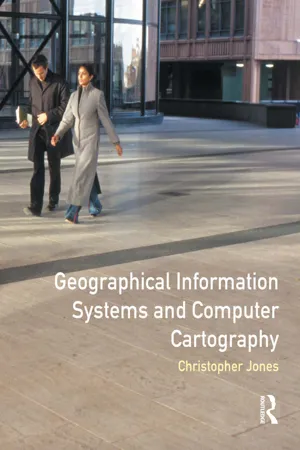Physics
Cartesian to Polar Coordinates
Cartesian to polar coordinates is a mathematical conversion used to describe the position of an object in two-dimensional space. It involves converting the x and y coordinates of an object into its radial distance from the origin and its angle from the positive x-axis. This conversion is commonly used in physics to describe the motion of objects in circular or rotational motion.
Written by Perlego with AI-assistance
Related key terms
Related key terms
1 of 4
Related key terms
1 of 3
6 Key excerpts on "Cartesian to Polar Coordinates"
- eBook - ePub
- Sandra L. Arlinghaus, Joseph J. Kerski, William C. Arlinghaus(Authors)
- 2023(Publication Date)
- CRC Press(Publisher)
https://commons.wikimedia.org/w/index.php?curid=33802846To convert from Polar Coordinates (r, φ) to Cartesian Coordinates (x,y), use the conversion equations, x = r × cos(φ), y = r × sin(φ), as suggested in Figure 4.10 .FIGURE 4.10 A diagram illustrating the relationship between polar and Cartesian coordinates. Source: No machine-readable author provided. Mets501 assumed (based on copyright claims), CC BY-SA 3.0 <https://creativecommons.org/licenses/by-sa/3.0/ >, via Wikimedia CommonsThe polar coordinate system may be extended to three dimensions as a cylindrical or spherical coordinate system. We confine ourselves here to coordinatization that is often found in mapping. Thus, we move on to a conceptual review of trigonometry which also sees abundant use in mapping.Trigonometry: Visual Review of Functions and Applications
All of our geometric analysis is based on Euclidean geometry, assuming Euclid’s Parallel Postulate: given a line and a point not on the line—through that point there passes exactly one line that does not intersect the given line. Non-Euclidean geometries violate this Postulate. What does the geometry of the Earth model become in the non-Euclidean world? Stay tuned and look for it in a later chapter! Now we offer an elegant visual summary of trigonometry that takes advantage of graphical animation, as a single visual capture of the entire set of elementary trigonometric functions.Visual Review of Trigonometric Functions
The Basic Setup
Figure 4.11 shows the basic set up, with terminology highlighted (Arlinghaus and Arlinghaus, 1989 ). Note the importance of language and “co-language.”FIGURE 4.11 The Basic Setup. A: axis and co-axis, complementary and orthogonal. B: angle θ. C: complementary angle, co- θ. Source: Arlinghaus and Arlinghaus, 2005 - Chris B. Jones(Author)
- 2014(Publication Date)
- Routledge(Publisher)
Figure 4.1c ). This type of coordinate system is of use in cartography when plotting certain types of projection in which position can conveniently be defined relative to a single, central point, rather than a pair of axes. It is also relevant in general when it is appropriate to retain a sense of relative direction.In mathematical usage, polar coordinate angles are conventionally measured anticlockwise from a horizontal axis (Figure 4.1c ). In surveying and cartography, the angles are usually measured clockwise from a vertical axis, the angular units being either degrees (0-360) or grads (0-400), where 90° and 100 grads are equivalent to π/2 radians.For a given origin, a cartographic polar coordinate of r,θ can be expressed in rectangular coordinates using the trigonometric formulaex = ? r sin θ , ? y = r cos θ ?Conversely, the polar coordinates can be expressed in terms of the rectangular coordinates by finding θ from the relationshiptan θ = x / yso that θ can be found using the appropriate inverse tan function on a computer. Knowing θ,r ? = ? y / cos θ ?? ? ? ?We may also note thato r ? ? ? r = x / sin θ ?r 2 ? ? = ? ?x 2 ? ? + ? ?y 2Spherical coordinates
We have seen that though planar coordinate systems are essential for constructing maps on flat surfaces, they cannot be used for representing extensive regions of the earth without introducing serious distortion in measurements such as distance and area. When high accuracy is not required these problems of distortion can be avoided by the use of a spherical coordinate system. This provides a single, consistent and relatively undistorted reference frame for recording positions and making measurements of the earth's surface. The coordinates can then be projected to a suitable planar coordinate system when a small-scale map of a particular region or aspect of the earth is required.- H. Davies, H.G. Davies, G.A. Hicks(Authors)
- 2014(Publication Date)
- Routledge(Publisher)
coordinates, are required to locate a point in a plane. Two systems are used:(a) Cartesian coordinates (x , y )
This is the most commonly used system. Two perpendicular datum lines are used, the horizontal line is called the x -axis, the vertical line is called the y -axis, as shown in Fig. 9.1 . The point of intersection of the two axes is called the origin O. Any point P is located by its perpendicular distance from the two axes.Fig. 9.1(b) Polar coordinates (r , θ )
In this system a point P is located at a distance r along a line OP from a fixed point O , called the pole, as shown in Fig 9.2 . θ is the angle that the line OP makes with the reference + x -axis. It is important to remember that θ is positive when OP rotates anticlockwise.Fig. 9.2Fig. 9.3Fig. 9.3 shows the relationship between both systems. Pythagoras’s theorem and trigonometry can be used to change from one system to another.(c) Conversion from Cartesian to Polar Coordinates
From PythagorasandThe smallest value of θ is usually quoted and can be positive or negative. The value of θ obtained must be checked so that it places P in the correct quadrant. This can be done by using a sketch to check the results, as shown in Example 9.1 .(d) Conversion from polar to Cartesian coordinates
From Fig. 9.3 , using trigonometrical ratios in a right-angled triangle:Example 9.1 The Cartesian coordinates of a point P are (–4, –6). Convert these to polar coordinates.The point P with these two coordinates is shown in Fig. 9.4 .Fig. 9.4The value of 56.3° is not in agreement with the position of P in the third quadrant. The smallest magnitude of θ is 180 – 56.3 = 123.7°, and this is seen to be negative because it is in a clockwise direction.The polar coordinates are (7.2, –124°).Example 9.2 Convert the polar coordinates (18, 125°) to Cartesian coordinates.Fig. 9.5From Fig. 9.5 ,The Cartesian coordinates are (–10.3, 14.7).9.3 The distance between two points
Fig. 9.6 shows two points P (x 1 , y 1 ) and Q (x 2 , y 2 )Horizontal distanceFig. 9.6- eBook - ePub
- Sivaji Chakravorti(Author)
- 2017(Publication Date)
- CRC Press(Publisher)
Figure 3.5 .As shown in Figure 3.5 , r is the distance from the pole to the projection of the point P on the polar plane, that is, the x–y plane passing through the pole, θ is the azimuthal angle, that is, the angle from the polar axis spinning around the z -axis in counter-clockwise direction, and z is the vertical height from the polar plane. The ranges of the values of the three coordinates are 0 ≤ r < ∞, 0 ≤ θ ≤ 2π and −∞ < z < ∞.FIGURE 3.5 Depiction of cylindrical coordinates of a point.In the cylindrical coordinate system, the three constant coordinate surfaces are defined by Equation 3.9f 1= r ,f 2= θ ,f 3= z ( 3.9 )Figure 3.6 shows the three constant coordinate surfaces in the cylindrical coordinate system. Out of these three surfaces, the first and the third surfaces, namely, f 1 = r and f 3 = z , are constant distance surfaces, whereas the second one, that is, f 2 = θ, is a constant angle surface. As shown in Figure 3.6 , the surfaces θ = constant and z = constant are planes, whereas the surface r = constant is a cylindrical surface.In this coordinate system, two unit vectors are defined on the x–y plane. The unit vector ûr points in the direction of increasing r , that is, radially outwards from the z -axis and the unit vector û θ points in the direction of increasing θ, that is, it points in the direction of the tangent to the circle of radius r in the counter-clockwise sense. The third unit vector ûz points in the direction of increasing z , that is, vertically upwards from the x–y plane. The unit vectors are shown in Figure 3.5 . The orthogonality of cylindrical coordinate system is defined by Equation 3.10 - eBook - ePub
- Jamal T. Manassah(Author)
- 2017(Publication Date)
- CRC Press(Publisher)
In this section, we will derive the expressions for the velocity and acceleration in polar coordinates and derive some of the most fundamental results of planetary motion physics. We will limit our discussion here to 2-D. A point is specified by the variables (r, θ). * The asterisk indicates more advanced material that may be skipped in a first reading. The basis vectors in polar coordinates are given respectively by e ^ r = cos (θ) e ^ 1 + sin (θ) e ^ 2 e ^ θ = − sin (θ) e ^ 1 + cos (θ) e ^ 2 (7.63) The above unit vectors are referred to respectively as the radial and tangential unit vectors. Geometrically, ê r points along the position vector r →, while ê θ is perpendicular to it and is pointing in the anticlockwise direction. Since both ê r and ê θ are dependent on the polar angle, in contrast to the Cartesian unit vectors which are the same everywhere, the time derivatives of these vectors are nonzero,. specifically d e ^ r d t = d θ d t (− sin (θ) e ^ 1 + cos (θ) e ^ 2) = d θ d t e ^ θ (7.64) d e ^ θ d t = d θ d t (− cos (θ) e ^ 1 − sin (θ) e ^ 2) = d θ d t e ^ r (7.65[--=PLGO-SE. PARATOR=--]) Consequently, the velocity and the acceleration vectors are given in polar coordinates. by v → = d r → d t = d r d t e ^ r + r d θ d t e ^ θ (7.66) a → = d v → d t = (d 2 r d t 2 − r (d θ d t) 2) e ^ r + (r d 2 θ d t 2 + 2 d r d t d θ d t) e ^ θ [--=PLGO-. SEPARATOR=--](7.67) Example 7.10 Using Newton’s second law of motion, show that if the force acting on a particle is radial, then the angular momentum of the particle is conserved. Solution: Newton’s second law of classical motion states that the force on a point particle is equal to its mass multiplied by its acceleration: F → = m a → (7.68) The angular momentum of a particle is equal to the cross product of its position vector and its momentum (= m ν →) - eBook - ePub
Parallel Robots
Mechanics and Control
- Hamid D. Taghirad(Author)
- 2013(Publication Date)
- CRC Press(Publisher)
spherical coordinate systems, may also be adopted.2.1 Spatial Motion Representation
The location or pose of a rigid body with respect to a reference coordinate system is known if the positions of all its points can be determined. Three independent parameters are sufficient to fully describe the location of a rigid body in a planar motion, and six independent parameters are needed to fully describe the spatial location or pose of that in three-dimensional space. Consider a rigid body in a spatial motion as shown in Figure 2.1 . Let us define a fixed reference coordinate system (x, y, z ) denoted by frame {A }, whose origin is located at pointOA. For representation of the rigid body location, a moving coordinate system is attached to the rigid body at pointOB. As shown in Figure 2.1 , this Cartesian coordinate system (u, v, w ), which is denoted by frame {B }, has a different position and orientation from that of the fixed frame. The absolute position of a point P of the rigid body can be constructed from the relative position of that point with respect to the moving frame {B }, and the position and orientation of the moving frame {B } with respect to the fixed frame {A }. Introducing a moving frame attached to the rigid body helps us in constituting the absolute position of an arbitrary point P as by its two components, namely, relative position of that point with respect to the moving frame {B } and absolute position and orientation of frame {B } with respect to frame {A }.FIGURE 2.1 Representation of a rigid body spatial motion.2.1.1 Position of a Point
The position of a point P with respect to a frame {A } can be described by a 3 × 1 position vector . If the coordinate frame is a Cartesian coordinate system, the three components of the position vector are the Cartesian components of a vector. If the position is described with respect to a fixed frame, the vector represents an absolute position, and if the frame of reference is moving itself, the representation results in a relative position vector. Because of the significance of the frame of reference to the representation of the position vector, the name of the frame is tagged to the position vector name as a leading superscript asA P, which is read as vector P in frame {A
Index pages curate the most relevant extracts from our library of academic textbooks. They’ve been created using an in-house natural language model (NLM), each adding context and meaning to key research topics.
Explore more topic indexes
Explore more topic indexes
1 of 6
Explore more topic indexes
1 of 4





